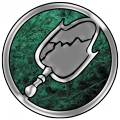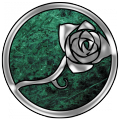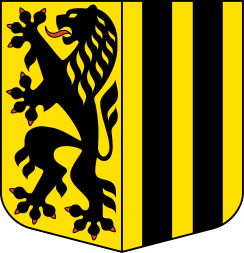Dresden
Appearance
File:Dresden by night1.png
Dresden is one of the greenest cities in all of Europe, with 63% of the city being green areas and forests. The Dresdner Heide to the north is a forest 50 km2 in size. There are four nature reserves. The additional Special Conservation Areas cover 18 km2. The protected gardens, parkways, parks and old graveyards host 110 natural monuments in the city. The Dresden Elbe Valley is a former world heritage site which is focused on the conservation of the cultural landscape in Dresden. One important part of that landscape is the Elbe meadows, which cross the city in a 20 kilometre swath. Saxon Switzerland is an important nearby location.
Dresden is a spacious city. Its districts differ in their structure and appearance. Many parts still contain an old village core, while some quarters are almost completely preserved as rural settings. Other characteristic kinds of urban areas are the historic outskirts of the city, and the former suburbs with scattered housing. During the German Democratic Republic, many apartment blocks were built. The original parts of the city are almost all in the districts of Altstadt (Old town) and Neustadt (New town). Growing outside the city walls, the historic outskirts were built in the 18th century. They were planned and constructed on the orders of the Saxon monarchs, which is why the outskirts are often named after sovereigns. From the 19th century the city grew by incorporating other districts. Dresden has been divided into ten districts called "Ortsamtsbereich" and nine former boroughs ("Ortschaften") which have been incorporated.
City Device
Climate
Dresden has a cold-moderate to continental climate, with hotter summers and colder winters than the German average. The average temperature in February is −1.7 °C (28.94 °F) and in July 18.1 °C (64.6 °F). The inner city temperature is 10.2 °C (50.4 °F) averaged over the year. The driest months are February and March, with precipitation of 40 mm (1.6 in). The wettest months are July and August, with 61 mm (2.4 in) per month.
The microclimate in the Elbe valley differs from that on the slopes and in the higher areas. Klotzsche, at 227 metres above sea level, hosts the Dresden weather station. The weather in Klotzsche is 1 to 1 to 3 °C (1.8 to 5.4 °F) colder than in the inner city.
Economy
In 1990 Dresden—an important industrial centre of the German Democratic Republic—had to struggle with the economic collapse of the Soviet Union and the other export markets in Eastern Europe. The German Democratic Republic had been the richest eastern bloc country but was faced with competition from the Federal Republic of Germany after reunification. After 1990 a completely new law and currency system was introduced in the wake of the collapse of the German Democratic Republic and eastern Germany's infrastructure was largely rebuilt with funds from the Federal Republic of Germany. Dresden as a major urban centre has developed much faster and more consistently than most other regions in the former German Democratic Republic, but the city still faces many social and economic problems stemming from the collapse of the former system, including high unemployment levels.
Until famous enterprises like Dresdner Bank left Dresden in the communist era to avoid nationalisation, Dresden was one of the most important German cities. The period of the GDR until 1990 was characterised by low economic growth in comparison to western German cities. The enterprises and production sites broke down almost completely as they entered the social market economy. Since then the economy of Dresden has been recovering.
The unemployment rate fluctuated between 13% and 15% within the first 20 years after Germany's unification and is still relatively high. Nevertheless, Dresden has developed faster than the average for Eastern Germany and has raised its GDP per capita to 31,100 euro, equal to the GDP per capita of some poor West German communities (the average of the 50 biggest cities is around 35,000 euro).
Thanks to the presence of public administration centers, a high density of semi-public research institutes which settle freely within Germany and a successful extension of high technology sectors through the help of public funding, the proportion of highly qualified workers is again among the highest in Germany and also in Europe-wide criteria, though - as all eastern towns in Germany - Dresden has a traditional shortage of corporate headquarters. Dresden is regularly ranked among the best ten bigger cities in Germany to live in. In May 2012 the unemployment rate reached a new low of 8.9%.
The current economy of Dresden is based on three distinct and primary industries: engineering, pharmaceuticals, and semiconductor production. Tourism is another distinct portion of the economy enjoying high revenue and many employees (There are something like hundred bigger hotels in Dresden with many of them in the upscale range).
The pharmaceutical industry saw its foundation develop at end of the 19th century. The Sächsisches Serumwerk Dresden (Saxon Serum Plant, Dresden), owned by GlaxoSmithKline, is a world leader in vaccine production. Another traditional pharmaceuticals producer is Arzneimittelwerke Dresden (Pharmaceutical Works, Dresden).
The semiconductor industry was built up in 1969. Major enterprises today are AMD's spin-off GLOBALFOUNDRIES, Infineon Technologies, ZMD and Toppan Photomasks. Their factories attract many suppliers of material and cleanroom technology enterprises to Dresden.
A third traditional branch is that of mechanical and electrical engineering. Major employers are the Volkswagen Transparent Factory, EADS Elbe Flugzeugwerke (Elbe Aircraft Works), Siemens and Linde-KCA-Dresden.
History
File:Dresden by Bernardo Bellotto 1748.png
"Although Dresden is a relatively recent city of Slavic origin, the area had been settled in the Neolithic era by Linear Pottery culture tribes ca. 7500 BC. Dresden's founding and early growth is associated with the eastward expansion of Germanic peoples, mining in the nearby Ore Mountains, and the establishment of the Margraviate of Meissen. Its name etymologically derives from Old Sorbian Drežďany, meaning people of the forest. Dresden later evolved into the capital of Saxony."
Prehistoric Times
As far back as historical records go, hunters and gatherers had always been attracted to the mild, fertile Elbe valley. The Germanic tribes which had been settling in the region began to move westwards in the 6th century. They were followed by Slavs from Bohemia, who chose the valley to found the village Drezdany. At the beginning of the 10th century, the German armies under King Heinrich I conquered the Slavonic lands between the rivers Saale and Elbe. The centre of their power was the castle of Meissen, which was founded in 929. The German conquerors were followed two centuries later by German settlers, who soon came to dominate the Slavonic population.
The Middle Ages
The original town corresponded approximately to the area of today's old city on the left bank of the Elbe.
In the early years, the expansion of the town and the development of trade and crafts progressed only very slowly. At the end of the 13th century, Dresden possessed a Franciscan monastery, at the end of the 14th century two hospices.
Around 1500, there were a mere 6,000 people living in the town, its suburbs and in the little town Altendresden, which had been established on the opposite bank of the Elbe, even though other towns in the region had already achieved a certain economic significance and urban development. In the 15th century, Hussite preachers were active in the Dresden, and in 1429, a Hussite army laid siege to the town.
A Royal Residence
In 1485, the estates of the Dukes of Meissen from the House of Wettin were divided between the sons of Duke Friedrich II. The Albertine line chose Dresden as the Wettin residence. Even though a devastating fire destroyed the town in 1491, Dresden was nonetheless able to enjoy its first heyday under Duke Georg the Bearded.
The Albertine court was one of the most influential opponents of the Reformation and the town was thus a centre of the resistance to Luther's teachings. Following the death of Duke Georg in 1539, however, his successor also initiated the Reformation in Dresden.
Significant cultural and economic activity developed in the town, determined above all by the needs and desires of the ducal court.
An Electoral Capital
In 1547, as a result of the Schmalkalden War, the Albertine princes were granted electoral privileges. Dresden hereby became the capital of what was not only the most important Protestant land, but at the same time also the most powerful German state after the Habsburg territories.
The city underwent rapid urban development under Elector Moritz: The transformation of the castle into a magnificent palace complex was continued, the armoury and mews were built, the mediaeval town wall was replaced with modern fortifications and the outer settlement along the Elbe around the Frauenkirche church was incorporated into the city.
The royal court promoted the development of the arts: in 1548, the »Hofcantorey«, the precursor of the Staatskapelle orchestra, was founded and the ground was prepared for the royal art collections.
The population of Dresden tripled between 1500 and 1600.
During the Thirty Years War
Electoral Saxony participated in the hostilities from 1620 onwards, fighting at various stages alongside both the Imperial and Swedish armies. Famine, plague and economic demise represented a serious setback for urban development, despite the fact that Dresden itself was never captured.
In the decades which followed, the city nevertheless rapidly revived its former glory, in no small way due to the continued promotion of cultural and economic development by the royal court.
The first manufactories were set up in the Friedrichstadt district, which was founded in 1670. The Grosser Garten park was laid out as a festive garden for the courtly society, the first Baroque architecture sprang up and the musical life of the city reached a first zenith with the works of Heinrich Schütz, who was engaged as music director in Dresden in 1614 and died here in 1672.
The Augustan Age
When Elector Friedrich August I (Augustus the Strong) acquired the Polish crown in 1697, Dresden advanced further to become a capital of European rank. The face of the city also changed dramatically.
Dresden became a city of Baroque. The royal court and the nobility commissioned extensive building work and encouraged exceptional artistic and craft-art achievements. Pöppelmann built the Zwinger and Taschenbergpalais in 1711, the Japanese Palais in 1715 and the summer palace in Pillnitz in 1721. The Frauenkirche was completed in 1734, the cathedral in 1755. The magnificent collections of the Picture Gallery and the Green Vault were established, and the first European porcelain manufactory, which was later to move to Meissen, was founded.
Among the cultural highlights of the reign of Augustus were the regular lavish festivities, which demonstrated not only an awareness for the arts, but also political claims to power. The needs of the royal court thus led to rapid economic development in the city, whose population tripled to 63,000 between 1700 and 1755.
In the wake of the courtly society, however, the Dresden bourgeoisie was also able to present notable achievements, as witnessed, for example, in the imposing town church architecture of the Frauenkirche.
After the Seven Years War
In August 1756, Prussian troops occupied the capital of Saxony, whose rulers had fled to Warsaw.
Dresden suffered several sieges in the years which followed, whole suburbs were burned down and in summer 1760 Prussian artillery also destroyed extensive areas of the city centre. Dresden recovered only very slowly from the after-effects of this period. It took 60 years before the population regained its pre-war numbers.
The former royal residence of European importance was now characterised by political provincialism, even though this period, too, brought forth individual cultural achievements of extraordinary quality.
Gottfried Körner and Anton Graff lived here, as did Winckelmann, Mengs and for a short time also Schiller. The arrival of Caspar David Friedrich in Dresden in 1798 established the city as a centre of Early German Romanticism. Novalis, E.T.A. Hoffmann and Kleist also stayed in Dresden over longer periods.
The Napoleonic Age
The events of the French Revolution were also followed attentively in Dresden – the »Pillnitz Declaration« against France was drawn up in 1791 – and led to certain social unrest.
In 1805, the French armies defeated and marched into Saxony, which thus became an ally of Napoleon. The latter stayed in Dresden on several occasions and it was here, in a bloody battle before the gates of the city in August 1813, that he celebrated one of his last victories.
Following Napoleon's defeat near Leipzig, Saxony was placed under Russian-Prussian governorship; in 1815, following the Congress of Vienna, it was required to cede half of its territories to Prussia.
The First-Half of the 19th Century
Following the years of Napoleonic rule, it was no longer the royal court alone which determined urban development in Dresden. Industrial enterprises were founded (in 1836 the Maschinenfabrik Übigau), a Technical School was opened in 1825 and the first long-distance railway in Germany was opened between Dresden and Leipzig in 1839.
Complete new city districts were established outside the now dismantled city fortifications. Around the middle of the 19th century, the population in Dresden already exceeded 100,000. Outstanding cultural and scientific achievements characterised the intellectual life of the city. Ludwig Tieck, Carl Maria von Weber, Carl Gustav Carus and Richard Wagner were all at home in Dresden.
The struggles for political reforms and for a modern, bourgeois state culminated in the failed May Uprising of 1849, in which Wagner and Gottfried Semper, among others, were also involved.
Dresden becomes a Major City
Dresden grew rapidly in the decades following 1850. The industrial branches which have become typical for the city, such as precision engineering, optics, luxury foods (chocolate) and cigarettes, were established.
Extensive traffic structures changed the appearance of the city: additional bridges over the Elbe, new railway lines and stations and an Elbe port were built. Dresden received a new city hall, a new opera house and numerous other public buildings. After the founding of the German Empire in 1871, the city was one of the most important garrisons and extensive barracks were erected.
At the turn of the century Dresden was the fourth largest city of the German Empire with a population of more than half a million inhabitants. Prudent building regulations enabled the city to maintain its charm despite its stormy growth. Together with the lively cultural climate, this founded Dresden's reputation as an attractive destination for thousands of tourists.
After 1900, the opera in Dresden attained world renown thanks to Richard Strauss, and when the artist group »Brücke« was founded in 1905, it also earned a name as a centre of expressionist art. The garden town Hellerau was at the same time an important focus of the German reform movement.
After the First World War
The November Revolution in 1918 also forced King Friedrich August III to abdicate. The Free State of Saxony was formed. The relative political stability in the second half of the 1920s once more brought forth notable architectural and cultural achievements.
Otto Dix and Oskar Kokoschka were important teachers at the Dresden Art Academy, and Mary Wigman and Gret Palucca established their European style of free dance in Dresden. The German Hygiene Museum was opened in 1930.
The assumption of power by the National Socialists in 1933, however, put an end to the progressive cultural traditions in the city. The brutal suppression of all political opposition culminated in the mishandling and finally the deportation of the Jewish citizens of Dresden.
Writer Victor Klemperer recorded their fate in his famous diaries.
The Destruction of Dresden
Three months before the end of the Second World War, a series of five air raids between 13th and 15th February 1945 practically erased the centre of Dresden and extensive areas of the suburbs. At least 25,000 people lost their lives.
The culturally and historically so valuable city centre was buried under 18 million cubic metres of rubble. Under indescribably arduous conditions, the remaining inhabitants of Dresden spared no effort in their attempts to restore the vital functions of the mortally afflicted city.
On 8th May 1945, the Soviet army occupied Dresden.
Reconstruction -- Refashioning the Jewel Box
In the first years after the war, the city centre was cleared of the enormous masses of rubble, with the assistance of tens of thousands of volunteer helpers. At the start of the 1950s, reconstruction began with residential and representative buildings in the city centre.
The reconstruction of selected architectural monuments was also forced ahead from the very beginning: the reconstruction of the Zwinger was completed in 1964. Further important buildings, such as the Court Church, Johanneum, Albertinum, the Royal Mews and, in 1985, the Semper Opera House, were also restored, though at the same time the valuable remains of other monuments were demolished.
Despite certain important successes, the later exclusive devotion to industrial construction technologies and increasing economic difficulties left the reconstruction of the city overall incomplete and unsatisfactory.
A Regional Capital within the GDR
In 1951, three years after the founding of the GDR, the East German Länder were dissolved and replaced by smaller administrative regions. Dresden became a regional capital.
Social life in the city was determined by the doctrines of socialist ideology. Despite considerable efforts, for example through the establishing of completely new branches of industry (computer technology, among others), only limited success could be recorded in attempts to regain the former standing of Dresden as an industrial centre.
Nine colleges, on the other hand, among them the Technical College, which was accorded the status of a university in 1961, were able to secure the city's scientific profile. Important cultural traditions were maintained and furthered in outstanding achievements in various arts.
The Kreuzchor choir and the Staatskapelle orchestra, the Palucca school of dance and the State Art Collections all enjoyed international renown. The re-opening of the Semper Opera House in 1985 was a particularly significant occasion.
Dresden since 1989
The peaceful revolution which heralded the end of the socialist GDR also had important roots in Dresden: It began with mass demonstrations at the beginning of October 1989. The so-called »Group of Twenty« was able to force the local authorities to enter into a dialogue with the new opposition. The peaceful occupation of the State Security headquarters followed in December.
After the unification of Germany, Dresden regained its former status as capital of the refounded Free State of Saxony. Extensive building work has in the meantime transformed the face of the city. Dresden is once more on the way to becoming one of the most attractive cities in Germany.
Location
Dresden lies on both banks of the river Elbe, mostly in the Dresden Basin, with the further reaches of the eastern Ore Mountains to the south, the steep slope of the Lusatian granitic crust to the north, and the Elbe Sandstone Mountains to the east at an altitude of about 113 metres (371 feet). Triebenberg is the highest point in Dresden at 384 metres (1,260 feet).
With a pleasant location and a mild climate on the Elbe, as well as Baroque-style architecture and numerous world-renowned museums and art collections, Dresden has been called "Elbflorenz" (Florence of the Elbe). The incorporation of neighbouring rural communities over the past 60 years has made Dresden the fourth largest urban district by area in Germany after Berlin, Hamburg, and Cologne.
The nearest German cities are Chemnitz 80 kilometres (50 miles) to the southwest, Leipzig 100 kilometres (62 miles) to the northwest and Berlin 200 kilometres (120 miles) to the north. Prague, Czech Republic is about 150 kilometres (93 miles) to the south and to the east 200 kilometres (120 miles) is Polish city of Wrocław.
Panorama
File:Dresden night panorama.png
Population
- City (780,561) - 2012 census
- Metro Area (1,143,197) - 2012 census
The population of Dresden reached 100,000 inhabitants in 1852, making it the third German city to reach that number. The population peaked at 649,252 in 1933, but dropped to 450,000 in 1946 as the result of World War II, during which large residential areas of the city were destroyed. After large incorporations and city restoration, the population grew to 522,532 again between 1950 and 1983.
Since German reunification, demographic development has been very unsteady. The city has had to struggle with migration and suburbanization. The population increased to 480,000 as a consequence of several incorporations during the 1990s, but it fell to 452,827 in 1998. Between 2000 and 2010, the population grew quickly by more than 45,000 inhabitants (about 9.5%) due to a stabilized economy and reurbanization. Along with Munich and Potsdam, Dresden is one of the ten fastest-growing cities in Germany, while the population of the surrounding new federal states is still shrinking. The population of the city of Dresden is 523,058 (2010), the population of the Dresden agglomeration is 780,561 (2008), and the population of Region Dresden (which includes the neighbouring districts of Meißen, Sächsische Schweiz-Osterzgebirge and the western part of the district of Bautzen) is 1,143,197 (2007). Today Dresden is one of the few German Cities which have more inhabitants than ever since World War II.
Arenas
- -- [[]] -- English: '
- -- [[]] -- English: '
- -- [[]] -- English: '
Attractions
- -- Fürstenzug of Dresden - The "Procession of Princes" is a 102 meter (335 foot) ceramic mural depicting the ancestral portraits of the 35 margraves, electors, dukes and kings of the House of Wettin between 1127 and 1904.
- -- [[]] -- English: '
- -- [[]] -- English: '
- -- [[]] -- English: '
Bars and Clubs
- -- [[]] -- English: '
- -- [[]] -- English: '
- -- [[]] -- English: '
Castles
- Dresdner Residenzschloss - Dresden Castle was the home of the Electors and Kings of Saxony for over 400 years until its destruction during W.W.II. It was recently restored to its full grandeur.
- Moritzburg Castle - Hunting lodge of the electors and kings of Saxony.
- Pillnitz Castle – Summer residence of the electors and kings of Saxony.
- -- Hubertusburg
Cemeteries
- -- [[]] -- English: '
- -- [[]] -- English: '
- -- [[]] -- English: '
City Government
- -- Sächsische Staatskanzlei - "Saxon State Chancellery or Saxon State Chambers
Churches
- -- Dresden Frauenkirche - "The Church of Our Lady" is a Lutheran church in central Dresden and an intrinsic part of the city skyline.
- -- Katholische Hofkirche - "The Catholic Church of the Royal Court of Saxony"
Crime
Citizens of the City
Gernot Maas: German forklift operator, husband & father of four. <deceased> - Drained to death by Yan Syrkov during an unexpected frenzy.
Fabiola Garver: German student, laborer and artist. <Critical Condition> - Drained nearly to death by Yan Syrkov during an unexpected frenzy.
Detektiv Lutz Metz: German Polizei officer in charge of missing persons.
Current Events
Galleries
- Landhaus of Dresden - The Landhaus is a historic building in Dresden, eastern Germany. Designed to house the Saxony region's Landstand, it was built in the Baroque style between 1770 and 1776 by Friedrich August Krubsacius on the site of the former Palais Flemming-Sulkowski. It now houses the Dresden City Museum and the Dresden City Art Gallery.
Hospitals
- -- [[]] -- English: '
- -- [[]] -- English: '
- -- [[]] -- English: '
Hotels & Hostels
- -- [[]] -- English: '
- -- [[]] -- English: '
- -- [[]] -- English: '
Hypermarkets
Landmarks
- -- Schloßplatz {Palace Square}
- -- [[]] -- English: '
- -- [[]] -- English: '
- -- [[]] -- English: '
Maps
Monasteries
Monuments
- -- [[]] -- English: '
- -- [[]] -- English: '
- -- [[]] -- English: '
Museums
- -- Staatliche Kunstsammlungen Dresden -- English: Dresden State Art Collections
- -- Deutsches Hygiene-Museum -- English: German Hygiene Museum
- -- Landesmuseum für Vorgeschichte -- English: State Museum of Prehistory
- -- Staatliche Naturhistorische Sammlungen Dresden -- English: State Collection of Natural History
- -- Universitätssammlung Kunst + Technik -- English: Collection of Art and Technology of the Dresden University of Technology
- -- Verkehrsmuseum Dresden -- English: Dresden Transport Museum
- -- Festung Dresden -- English: Dresden Fortress
- -- Stadtmuseum Dresden -- English: Dresden City Museum
- -- Militärhistorisches Museum der Bundeswehr -- English: Bundeswehr Military History Museum
- -- Sächsische Landesbibliothek – Staats- und Universitätsbibliothek Dresden -- English: Saxon State and University Library Dresden
- -- Botanischer Garten der Technischen Universität Dresden -- English: Dresden Botanical Garden
- -- Zwinger Palace
Neighborhoods
Parks
- -- Großer Garten -- English: Great Garden
- -- [[]] -- English: '
- -- [[]] -- English: '
Private Residences
- -- [[]] -- English: '
- -- [[]] -- English: '
- -- [[]] -- English: '
Restaurants
Ruins
- -- [[]] -- English: '
- -- [[]] -- English: '
- -- [[]] -- English: '
Schools
- -- [[]] -- English: '
- -- [[]] -- English: '
- -- [[]] -- English: '
Shops
Theatres
- -- Semperoper - The Opera House for the Saxon State Orchestra of Dresden.
Transportation
Vampires of the City (8)
 Zelenka Brujah
Zelenka Brujah
- -- Vladan Kladivo -- The New Prince of Dresden -- "The Prince is dead, long live the Prince."
- -- Dalibor Biskup -- The New Seneschal of Dresden - "Uneasy is the head that wears the crown."
- -- Hiltrude Ott -- Dresden's Security Chief (read that as sheriff in virtually any other European Camarilla city).
- -- Verena Bambach -- First and only childe of the prince.
 Clan Malkavian
Clan Malkavian
- -- Gitta Wörnhör - The Reluctant Transplant.
 Clan Nosferatu
Clan Nosferatu
- -- Bartolomej - The Lonely Leper.
 Clan Toreador
Clan Toreador
- -- Mareike Kneller - Paramour of Dalibor Biskup.
 Clan Tremere
Clan Tremere
- -- Ottomar Specht - Regent Appointee to Dresden.
 Clan Ventrue
Clan Ventrue
- -- Kreszentia Suse Brandt - Business associate of the new prince.
 Deceased and Exiled vampires of Dresden
Deceased and Exiled vampires of Dresden
- -- Oliver Zelenka - Former Prince of Dresden (Deceased - Diablerie - Countess Klara Wehunt)
- -- Sara Zuraw - Youngest childe of Oliver Zelenka, first and former prince of Dresden.
Stories of the Jewel Box
- -- Story 33 - The Jewel Box
- -- Once Upon a Time in Dresden (October 0f 2031)
Websites
http://www.dresden.de/index_en.php
http://en.wikipedia.org/wiki/Dresden
